

"If the stones could speak", then Youghal would keep a listener enthralled, for the walls of its fortifications and many of its buildings date back to medieval times. The stones bear mute witness to a very interesting history.
Some of the ancient stones that you can touch in Youghal take the form of gateways, and gateways are (as we shall illustrate below) very important in human experience.
This page outlines the history of Youghal, including the involvement of Sir Walter Raleigh and Sir Richard Boyle.
12th Century - Norman Invasion
15th Century - Prosperity & Pirates
16th Century - Rebellion, Plantation & Raleigh
17th Century - Boyle, Pig-Iron, Cromwell & Civil War
18th Century - Rebellion, Expansion, Prosperity
Little is known about the earliest settlement of Youghal. Its geographical position, a piece of flat land at the mouth of a great river, together with an abundance of pottery clay, would make it an obvious base. Here one could fish river and sea, trade upriver and overseas.
The earliest settlement evidence for the area is from the Mesolithic, approximately 8,000 years ago These early hunter/gatherers exploited the rich resources of the area and almost certainly arrived by sea. They were followed by succeeding waves of immigration bringing cultural changes and new ideas. The earliest farmers who arrived about 5,000 years ago are also represented in the landscape as are those of the bronze metal working culture of 3,800 years ago.
Evidence in the form of a mesolithic stone backed blade was found at Newport outside Youghal, while a mudstone axe was discovered near the old brickworks.
The Celtic culture arrived here 2,500 years ago and many fine fortified enclosures, raths, survive in the countryside around Youghal. The earliest settlement at Youghal was probably a rath, which is remembered by the very old road running around the town called Raheen Road.
There is evidence of contact with Roman Britain in the period before the coming of Christianity but no evidence of Roman presence here.
The name "Youghal" derives from the old Irish "Eochaill" - meaning "Yew wood".
The earliest evidence of Christianity in the Youghal area is two small religious foundation. In the western suburb of the town is the site of the Church of Coran and the founder's hermitage nearby. This foundation may have been associated with the important monastery at Ardmore (5th century - 7 miles to the east).
Molana, an island monastery three miles north of Youghal, founded in the early 6th century, became a great centre of learning and religious reform during the 7th - 10th centuries
Rath is a locally used placename and is suggestive of the presence of a settlement or homestead in a ringfort (fairy fort) in Youghal in Early Christian times.
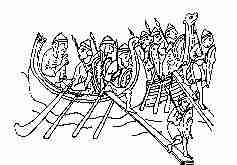
The Vikings used Youghal as a base from which they could raid the wealthy monastic sites along the south coast - such as Ardmore - or those further up the Blackwater River - at Molana and Lismore ( 18 miles upriver).
They established a settlement at Youghal from which to carry on their trade and it is recorded that in 864 the Deise clan from the neighbouring countryside destroyed the Norse fort at Youghal. A century later in 945 the Vikings were sufficiently settled to be involved in a major battle with their own kinsmen outside Youghal.
No traces of the Viking times have yet been uncovered, but a stone in the transept of St Mary's Collegiate Church bears the faint etched outline of a longboat.
Hostilities with these Norwegian and Danish settlers all but ceased after the Battle of Clontarf, in which the armies of the Irish, under the command of Brian Boru, defeated the Vikings. Youghal took on the mantle of a trading port and began to service the vast hinterland of East Cork and West Waterford.
1169/1171 - Anglo Norman involvement in Ireland began in this period resulting in a flail invasion in 1171 in which they captured about half tile country but only fully subdued about one third.
P>1173 - a Norman raiding party under Strongbow had embarked their booty at Youghal for shipment to their stronghold at Waterford when they were surprised by the Irish fleet out of Cork including Gaelicised Vikings. A sea battle was waged at the harbour mouth with the Normans victorious.1177 - The area around Youghal was granted by Henry II to Robert Fitzstephen
The Normans rebuilt and extended the Viking fortifications of the town.
Youghal quickly gained power and influence in both Ireland and Europe, second only in stature to Bristol as the busiest port in the British Isles. "Men-at-arms, traffickers and other adventurers" of that port colonised the town throughout the 13th century.
1202 - Youghal received its first charter from King John.
1215 - Robert Fitzstephen passed the lands on to his half-brother Maurice Fitzgerald - ancestor of the Earls of Desmond.
 Maurice Fitzgerald
Maurice Fitzgerald
These Anglo-Norman lords gradually adopted native Irish customs and intermarried with the Irish. There is a saying that "they became more Irish than the Irish themselves".
1220 - St. Mary's Collegiate Church was built on the site of an earlier 11th c church.
 St. Mary's
St. Mary's
The church still stands and is one of the few remaining medieval churches continuous use as a place of worship.
The church contains some very interesting tombs, effigies and monuments. Among them is the elaborately sculptured tomb of Richard Boyle (1566-1643).
1224 - Franciscan Abbey founded south of the town in the lifetime of St. Francis - by tradition, the foundation house of the order in Ireland.
The benefactor was Maurice Fitzgerald, Baron of Offaly, who was buried there in 1257. His grandson, Thomas Fitzmaurice, was the patron of the Dominican friary.
Both friaries were abandoned following the order of Henry VIII for the dissolution of monasteries.
1268 - Dominican priory founded close to North Gate. The ruins of the North Abbey can still be seen.
1275 - Edward I levied a tax for the building of stone walls to replace the Norman walls.
 Town Walls
Town Walls
Further charters for the same purpose in 1358, 1375, 1431, 1462, 1489, 1497,1584 and 1609.

1301 - Such was the measure of esteem in which Youghal was held as a trading port and naval centre that it was the only town in Ireland required to send three ships to aid Edward I in his Scottish Campaign.
However it ultimately provided 9 of the total of 27 ships from all of Ireland which took part in the campaign.
1350 - Youghal was a fine walled town, trading with ports all over Europe. The town walls and its fosse on the west side, with at least 12 towers, surrounded the settlement, stretching up the hill behind the houses to prevent attack from the higher ground.
Evidence of 13th/14th century houses were discovered during archaeological excavations at Chapel Lane and North Main Street.
1360 - St John's priory was founded in the Main Street as a minor house to the Benedictine Priory in Waterford. Small portions of the building still survive including the door arch and a small window on the street front.

By the 15th century, a small extension to the walls had been made to the south to create a 'base town' with an adjoining quay. The three main openings in the walls were the Watergate, which opened onto the quays, the North Gate, the principal landward entrance to the town and the Iron gate at the southern edge. The Iron gate was later called the Trinity Gate and is now the site of the Clock Gate.
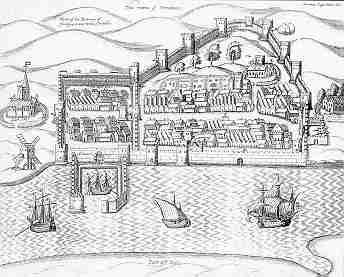
The southern - liberties - gate was the entrance to the Base Town (lower classes) which was separated from the Town Proper by the Clock Gate.
The wall also had various sally ports and minor gates.
 The Watergate
The Watergate
The Watergate was the only access to the quay from the town. This gate was one of the busiest places in Youghal. All traders, adventurers, soldiers, clergy and prisoners bound to and from the sea passed through here.
1462 - Youghal was created one of the Irish 'cinque ports', granting the town special trading privileges.
As the influence and wealth of the Town increased, the rich pickings attracted the attentions of Algerian Pirates. Throughout the 15th century, these corsairs raided up and down the coast of Cork and Kerry, looting towns and monasteries and taking slaves.
One pirate captain, who rejoiced in the name of Nut, commanded three heavily armed ships. He is reputed to have buried treasure on headlands along the coast and to have buried a male slave with each trove. (Youghal gardening tip - If you find a skeleton, keep digging)
1464 - The College, at Emmet Place, was Ireland's first post-Norman University. It was founded by Thomas Fitzgerald, 7th Earl of Desmond.

Pupils were aged 12-17 years, sons of the Hiberno-Norman gentry and perhaps the wealthier merchants of the town.
St. Mary's became the Collegiate Church.
The College being a monastic establishment, was dissolved under the order of Henry VIII but struggled on until acquired for use as a residence by Richard Boyle, First Earl of Cork.
Tyntes Castle, a 15th c fortified castle was built on the Main Street by the Walshes, a family of Norman descent. It is unusual to have a fortified dwelling inside the town walls. It is thought to have been a store for valuable goods, with living quarters overhead.
The tower passed into the ownership of Sir Robert Tynte in the 17th century. Tynte married the widow of the famous poet Spencer.
The original windows can still be seen on the top floor. The lower windows have been altered.

Throughout the 16th and 17th centuries, the town rose and fell as civil war and rebellion tore the countryside apart.
The power and possessions of the Earls of Desmond generated concern and envy in the English administration. The Earls constantly tested the limits of their power and independence from the English. The Earls were feudal lords who did not take kindly to interference by monarch and administration.. Inevitably, the situation led to open rebellion.
1568 - A rebellion led by James Fitzmaurice, cousin of the Earl of Desmond, was put down.
1579 - Fitzmaurice returned from the continent to lead another revolt.
Gerald Fitzgerald, the 14th Earl of Desmond, was drawn into the conflict.
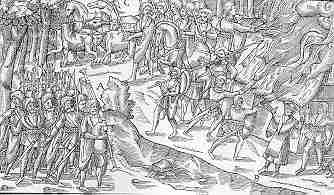
The town's defences had not been maintained properly, and Youghal soon fell to Desmond's army. The town was sacked and its fortifications broken.
The English, led by the Earl of Ormond, recaptured Youghal some weeks later. The English forces sent to quell the rebellion then had their turn at terrorising the town.
The Lord Mayor, Patrick Coppinger, was hanged from his own doorway for failing to maintain the strength of the town's defences.
1583 - Desmond failed to retake the town. His vast estates of 300,000 acres, mostly in County Limerick, but also in north Kerry, north and east Cork and west Waterford were confiscated.
Elizabeth I then began to parcel out the confiscated lands to her faithful supporters and military officers, and thus began the Munster Plantation, in which lands were granted on condition of establishing colonies of English in order to quell rebellion and develop resources.
As with the Laois/Offaly Plantation of 1556 and the later Ulster Plantation of 1607, the Englishmen granted the lands undertook to:
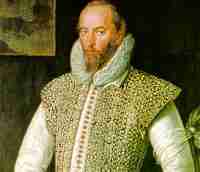
Raleigh came to Ireland as part of the army sent to put down the Desmond Rebellion.
42,000 acres extending from Youghal (The Inchiquin Seignory) were granted to the Queen's favourite, Sir Walter Raleigh. (Born 1552)
Youghal was home to Raleigh for short periods during the 17 years in which he held the lands.
His stately Elizabethan house, Myrtle Grove, built mid 16th century, was originally the residence of the Warden of the College of Youghal.

Myrtle Grove is rare example of a 16th century house that has survived largely intact. Although the house was altered in the 16th,18th and 19th centuries, it retains its original character and contains some interior features which probably date back to the 1580s.
1585 - The first potatoes in Ireland were planted in the gardens of Myrtle Grove. It is possible that the house witnessed the beginning of tobacco smoking in Ireland.
1588/1589 - Raleigh was Mayor of Youghal.
1588 - The poet, Spencer was a contemporary of Raleigh's and had been granted lands in North Cork. Spencer is said to have been inspired to write the "Faerie Queen" while looking out the window of Myrtle Grove.
Raleigh's fortunes were in decline in the 1590's. He had limited success in inducing English tenants to settle on his estates. His major activity had been the export of oak and yew. Rebellion had once again ravaged the poorly-defended plantation.
English settlement and its defence was the primary reason that lands were granted. He was also involved in the ill-fated colonies in Virginia and especially on Roanoke Island.
The failure gave advantage to his enemies at court.
1602 - Raleigh eventually sold his Irish possessions in 1602 to Sir Richard Boyle (the first Earl of Cork).
More on Raleigh below - but first -
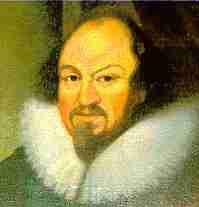
Boyle (born 1566) had arrived in Ireland in 1588 with few possessions. He married wisely (to a very rich heiress) in 1595 and so had the resources to purchase the estates of Raleigh.
Boyle recognised the suitability of Youghal area for the production of pig iron, for which there was great demand in England. A plentiful supply of timber for charcoal, rich iron ore deposits, water power and a fine port all combined to create a busy iron industry in the early 17th century.
The Yew woods from which Youghal derived its name (Irish: Eochaill) were used to feed the ironworks of Richard Boyle during the 17th century.
(Yew woodn't believe how many trees used to grow around here.)
Boyle acquired (apparently by devious means) and converted the former College into a mansion for his own use.
He brought over settlers from England, mainly from the Bristol area. In 1616 he was elevated to Lord Boyle in recognition "of the introduction into maritime ports of our Province of Munster, and particularly in the neighbourhood of Youghal, a very excellent Colony, consisting of veteran soldiers and many other persons, brought by himself out of England."
Amongst the other reminders of Boyle's influence in Youghal are the Almshouses, which he endowed to house six old soldiers, who were to receive a pension of £5 per annum. This service was later extended to include widows. The six houses were built in 1610 and continued in use in their original form until the mid-19th century, when some alterations took place. They are now owned by Youghal Urban District Council and still serve a similar generous purpose.

Boyle renovated the south transept of St. Mary's Collegiate Church, which had been damaged in the Desmond rebellion. He had an elaborate monument built depicting himself, his two wives, and some of his 15 children.
His seventh son , Robert Boyle was a famous chemist (The Boyle of "Boyle's Law) whose work was the forerunner of the modern theory of chemical elements.
Boyle died in 1643 and is buried in St.Mary's Collegiate Church.
Contrast Boyle's success with the misfortunes of his predecessor, Sir Walter Raleigh, the dashing, dynamic adventurer and poet.
Raleigh sold his (failed) Irish estates to Boyle in 1602. He then displeased Elizabeth I by having a love affair with one of the Queen's Maids of Honour (unacceptable behaviour for one of this queen's favourites). He was thrown into the Tower of London but was released some time later when one of his ships brought back a huge treasure on a captured Spanish ship.
Elizabeth died in 1603. Raleigh was framed as a member of a plot against the new ruler, James I, and was sentenced to life imprisonment.
He was released after 13 years in the Tower. The condition was that he apply himself to obtaining gold in South America.
In 1617, Raleigh was back in Youghal again, preparing his ill-fated expedition to the Orinoco River in search of gold. The expedition was not a success and he was executed on his return to England in 1618.
Questions arise (in the mind of this writer at least) which you, gentle reader, may like to consider.
To enhance your considering experience, you may like to perform it while standing under the arch of the Watergate in Youghal. For it is through this same arch, the only gateway to and from the sea, that Raleigh left Youghal for the last time, and poetic soul that he was, he may have touched these stones and considered similar questions.
Boyle's monuments are extraordinary ornate memorials, and are in St. Mary's Collegiate Church in Youghal and in St. Patrick's Cathedral in Dublin.
Raleigh's monuments are his poems and the stories of his adventures.
1611- A public clock was very important to the life of a medieval town. The first such clock was on the Trinity Gate (Now the Clock Gate). Wealthy merchants would become entitled to privileges by paying for the clock parts.
1641-1650
The English Civil War provided opportunities for rebellion in Ireland.
Boyle Senior remained a Royalist to his death. His son, however changed sides in timely maneuvers which saved his estates and the town of Youghal.
In 1642, English reinforcements landed at Youghal, in spite of the Irish guns at Ferrypoint.
In 1645, Admiral William Penn commanded two frigates which were part of an unsuccessful attempt to supply aid to the garrison. The Admiral was later granted land by Cromwell. Penn's son, also called William was born near Youghal and was founder of Pennsylvania in the United States.

In July 1649, Oliver Cromwell landed in Ireland in order to put down rebellion and ensure support for his war in England. Cromwell wintered in Youghal. The geographical location of the town offered Cromwell a strategic headquarters from which he could strike at any of the major towns of the south of Ireland. Cromwell departed Ireland from Youghal on May 29th, 1650. Tradition has it that he left via the Watergate, which was thereafter known locally as Cromwell's Arch.
During the archaeological excavations at Chapel Lane, the remains of 16th/17th century houses were uncovered.
At the end of the 17th century, Youghal had 33 registered vessels, while its main rivals of Cork and Kinsale had 24 and 22 respectively.
Youghal emerged from the turbulent years of the 17th Century in to a period of growth during the 18th century. Trade expanded, with quays and warehouses being built on reclaimed land between the medieval town and the river.
Youghal's population grew from nearly 4000 in 1764 to over 10,000 by 1821.
The Red House, a Queen Anne style house dating from 1703, was built by the Dutch architect Leuventhan for the Uniacke family.

1756- John Wesley opened the Wesley Chapel on Chapel Lane.
1777 - The Clock Gate was built on the site of Trinity Castle, part of the town's fortifications. The old Trinity gate had separated the Base Town from the medieval town proper.
 The Clock Gate served the town as goal and public gallows until 1837.
The Clock Gate served the town as goal and public gallows until 1837.
1787 - A new storey was added to the Clock Gate Tower to cater for the rising number of people arrested as rebels.
It was a grim building - prisoners were routinely tortured for information. Sometimes they were flogged and deported. Several members of the United Irishmen were publicly hanged from the windows. The Clock gate was a symbol of terror and tyranny for the countryside around.
1779 - The Mall House, containing Assembly Rooms was built on a newly-built promenade along the river front. It is now used as Youghal's Town Hall.
1796 - St. Mary's Catholic Church was built.
Thanks to the historians and archaeologists of Youghal for the historical details.
Any frivolous / speculative content is entirely the fault of ALIA.